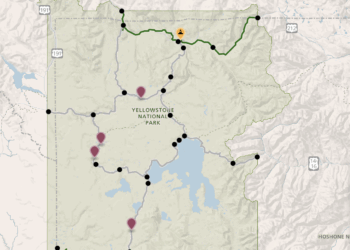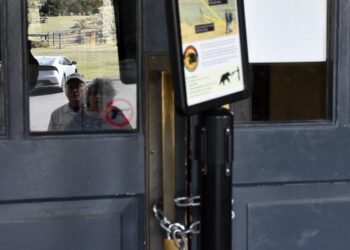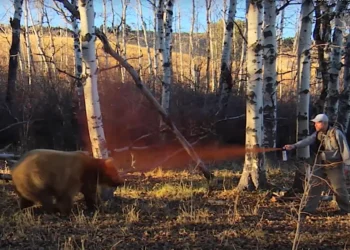On June 29, Yellowstone National Park released a draft Supplemental Environmental Impact Statement/Winter Use Plan that contains alternatives for managing the park in winter.
Ultimately, the SEIS will establish a framework for managing the parks’ winter resources and values. This Draft SEIS will determine whether motorized winter use in the interior of the park is appropriate, and if so, the type, extent and location of this use. The range of alternatives may be found below.
The draft SEIS has three proposed action alternatives, and one that would leave the status quo. Its stated objectives are to provide for visitor use, experience and accessibility; protect resources, including wildlife, sound, air quality and wilderness; ensure health and safety; to improve coordination and cooperation; and promote park operations and management.
The National Park Service’s preferred alternative, Alternative 4, groups visitors in “transportation events.” One event equals seven snowmobiles together, or a single snowcoach, and management is according to the groups’ effects on the park.
Park officials believe this kind of management would provide “a sustainable solution for winter use management that protects park resources,” and allow for “greater flexibility, a cleaner, quieter park, and… more visitors into the park.”
The comment period for the draft SEIS will close Aug. 20. In the meantime, the NPS will hold four open house meetings in local communities—West Yellowstone, Cody, Bozeman and Jackson—to present its preferred alternative, answer questions and formally hear public comments.
For more information, visit the Yellowstone Winter Use website: nps.gov/yell/planyourvisit/winteruse
Range of alternatives
All action alternatives would include development of Best Available Technology for snowcoaches by the 2017-2018 season, BAT standards for snowmobiles, 100 percent guided snowmobile use, Sylvan Pass Avalanche Control for Alternatives 2 and 4, and adaptive management. Sylvan Pass would be closed under Alternative 3.
Alternative 1: No action
• Public OSV use wouldn’t be permitted because the 2009 to 2012 interim regulations expired after the 2011/2012 season.
• Non-motorized access throughout the park and wheeled vehicle use along the northern road would still be allowed.
Alternative 2: Continue snowmobile/snowcoach use at 2011/2012 limits
• Up to 318 snowmobiles and 78 snowcoaches would be allowed daily.
• All OSV interim regulation requirements would continue, including commercial guiding and BAT standards for snowmobiles.
Alternative 3: Transition to BAT snowcoaches
• This would initially provide up to 318 snowmobiles and 78 snowcoaches per day, the same levels as the interim regulation.
• After the 2017/2018 season, when all snowcoaches must meet BAT requirements, snowcoach numbers would increase up to 120 per day, with a corresponding decrease in snowmobile numbers to zero during a three-year phase-out period.
• East Entrance to Fishing Bridge (Sylvan Pass) would be closed to OSVs during the winter season once the phase-out of snowmobiles is complete.
Alternative 4 (NPS preferred alternative): Manage OSV use by transportation events
• 110 total transportation events per day, with up to 50 events allocated for snowmobiles.
• Snowmobiles and snowcoaches will be subject to robust sound emission standards—68 decibels and 75 decibels, respectively by the 2017/2018 season.
• Operators would decide how to split their daily allotments of transportation events between snowmobiles and snowcoaches.
• Should OSV improve further and vehicles meet an enhanced BAT standard of 66 dBA for snowmobiles and 71 decibels dBA for snowcoaches, additional vehicles may be added to each transportation event.
• All snowmobile use in the park would be guided. One non-commercially guided group of up to five snowmobiles would be permitted into the park daily through each entrance. Non-commercial guides and members of their group operating snowmobiles would be required to complete both online and on-site training.
Get involved
Public participation will help shape this project, and there are a number of ways to be involved:
Submit comments electronically
logon to http://parkplanning.nps.gov/yell and select “2012 Draft Supplemental Environmental Impact Statement.”
Submit written comments by mail or hand delivery
Yellowstone National Park
Winter Use SEIS
P.O. Box 168,
Yellowstone National Park, WY 82190
Attend a public meeting
Jackson, Wyo.
Monday, July 16, 6:30 – 9 p.m.
The Virginian, 750 West Broadway
West Yellowstone
Tuesday, July 17, 6:30 – 9 p.m.
The Holiday Inn, 315 Yellowstone Avenue
Bozeman
Wednesday, July 18, 6:30 – 9 p.m.
The Wingate by Wyndham, 2305 Catron Street
Cody, Wyo.
Thursday, July 19, 6:30 – 9 p.m.
The Holiday Inn, 1725 Sheridan Avenue













